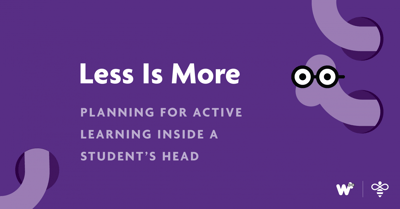 I wonder how many children got off the school bus today and told their caregivers that they didn’t learn anything in school? Unfortunately, I know now that many of them are telling the truth.
I wonder how many children got off the school bus today and told their caregivers that they didn’t learn anything in school? Unfortunately, I know now that many of them are telling the truth.
They may have engaged in activities. They may have completed tasks. They may not have learned actively, especially if their teachers did not have access to a high-quality, challenging curriculum.
As we wrote and tested Bookworms K–5 Reading and Writing, we wrestled to ground our work in a commitment to active learning. Like many ideas in education, we had to counter some theories with widespread support but no evidence. Here are three ideas we excluded:
- Active learning in literacy only happens with manipulatives.
- Active learning in literacy only happens with frequent physical movement.
- Active learning in literacy only happens with frequent teacher summarizing.
Using manipulatives, moving around the classroom space, and summarizing are all good things to do. But they are not the heart of active learning that underpins Bookworms K–5 Reading and Writing. The active learning that we were after happens inside a student’s head.
We built our work on a commitment to active learning, simply defined. Active learning in literacy only happens when students are actively reading, writing, listening, and speaking about complex ideas. Active learning requires strong foundational skills, interest and motivation, and self regulation. Students build all of those things if and only if they are a requirement. The older they are, the longer they should be able to engage in active learning without teacher interruption.
If we want students to voluntarily engage in active learning, we have to provide them interesting things to learn about. For us, that meant choosing good books. Real books. Books that contain complex plots, rich characters, and extensive information about the world. Books that could engage the imagination and books that could build language and content knowledge in all areas.
In planning our instruction, we engaged in a balancing act. Basically, we needed to replace time typically spent with teachers talking to reserve more time for reading these wonderful books and for writing about them. First, we minimized the time that would be spend on foundational skills by moving that work into small, carefully formed groups. That increases intensity and minimizes time. It means that students who need more time on foundational skills can get it while others who need no time don’t waste it. Instead, they read more.
Next, we minimized the time spent describing comprehension strategies. We placed comprehension strategy modeling inside texts, with short daily descriptions of expert thinking. We used the very same language from kindergarten through fifth grade, in shared reading and in teacher read alouds. Again, we increased the instances of strategy examples which decreasing the time spent in any one instance.
At the same time, we narrowed the focus for writing to the highest-utility writing: text-based arguments and summaries, narratives with a sequence of events, opinions with evidence, and informational text with strong structure. We created tools for students to use to plan, to revise their own work and provide feedback to their peers, and to edit. Like our comprehension strategy talk, these tools are structured to be familiar to students over time (saving teacher explanation time). They simply build in complexity as students move to the next grade.
From my college days, I remember the famous quote from modernist architect Mies van der Rohe, “Less is more.” I also remember the quip from American architect Robert Venturi, “Less is a bore.” Here’s how my study of architectural history shaped Bookworms K–5 Reading and Writing. Less teacher talk about reading and writing is more. Students need to read more. Students need to write more. But the books we place in front of students can’t be a bore. The most motivating tool in a teacher’s toolbox is a really interesting book. In Bookworms K–5 Reading and Writing, we stacked the deck for teachers.

